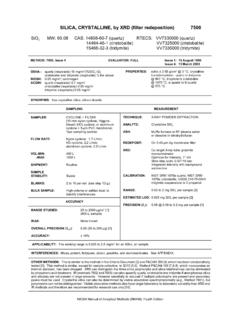Transcription of SILICA, CRYSTALLINE by IR (KBr pellet) 7602
1 NIOSH Manual of Analytical Methods (NMAM), Fourth EditionSILICA, CRYSTALLINE by IR ( kbr pellet )7602 SiO2MW: :14808-60-7 RTECS:VV7330000 (quartz) 14464-46-1VV7325000 (cristobalite) 15468-32-3VV335000 (tridymite)METHOD: 7602, Issue 3 EV ALU ATI ON : P ARTIALI ssue 1: 15 February 1984 Issue 3: 15 March 2003OS HA :quartz (respirable): 10 mg/ m3 / (% SiO2 + 2); cristobalite and tridymite (respirable): 1/2 the above NIOSH: mg/m3 ; carcinogensACGIH: quartz (respirable) mg/m3 cristobalite and tridymite (respirable) mg/m3 PROPERTIES:solid; d g/cm3; crystallinetransformation: quartz to tridymite @ 867 C; tridymite to cristobalite @ 1470 C; "-quartz to $-quartz @ 573 CSYNONYMS: free CRYSTALLINE silica .
2 Silicon dioxideSAMPLINGMEASUREMENTSAMPLER:CYCLON E + FILTER (10-mm nylon or Higgins-Dewell (HD), andPVC filter, 37-mm, 5- m)*see sampling sectionFLOW RATE:Nylon L/minVOL-MIN:400 L -MAX:800 LSHIPM ENT:RoutineSAMPLESTABILITY:StableBLANKS: 2 to 10 field blanks per setBULK SAMPLE:High volume or settled dust to identifyinterferencesTECHNIQUE:INFRARED ABSORPTIONSPECTROPHOTOMETRYANALYTE:Quart zASH:Muffle furnace of RF plasma asherPELLET:Mix residue with KBr; press 13-mm pelletIR:Scan absorbance from 1000 to 600 cm-1 CALIBRATION:NIST SRM 1878a quartz, NIST SRM1879a cristobalite, USGS 210-75-0043tridymite diluted in KBrRANGE:10 to 160 g quartzESTIMATED LOD:5 g quartzPRECISION ( r):< @ 30 g quartz per sample, incoal dust [1]ACCURACYRANGE STUDIED:Not studiedBIAS:Not determinedOVERALL PRECISION ( rT):Not determinedACCURACY:Not determinedAPPLICABILITY: The working range is to mg/m3 for a 400-L air sample.
3 Cristobalite and tridymite also have majorabsorbance peaks at 800 cm-1 which can be used for their determination [1-6]. IR methods can quantify quartz, cristobalite andtridymite if amorphous silica and silicates are not present in large amounts. However, sensitivity is reduced if multiplepolymorphs are present and secondary peaks must be used. A potential for bias exists when correcting for matrix absorptioneffects, with an increasing risk of bias at lower quartz concentrations. See also discussion of CRYSTALLINE silica in Chapter R ofthis volume [7].
4 INTERFERENCES: Amorphous silica , calcite, cristobalite, kaolinite and tridym ite interfere; see METHODS: This is P&CAM 110 in a revised format [1]. It is similar to Method 7603, except for sample preparation( kbr pellet vs. redeposition). XRD (method 7500) can distinguish the three silica polymorphs and silica interferences can beeliminiated by phosphoric acid treatment. CRYSTALLINE silica can also be determined by visible absorption spectrophotometry( , method 7601), but polymorphs cannot be distinguished. Visible absorption methods also have larger laboratory-to-laboratory variability than XRD and IR methods and therefore are recommended for research use only [8].
5 silica , CRYSTALLINE by IR: Method 7602, Issue 3, dated 15 March 2003 - Page 2 of 6 NIOSH Manual of Analytical Methods (NMAM), Fourth EditionREAGENTS: 1. silica Standards. * (SRMs 1878a, 2950, 2951,2958) and Cristobalite* (SRMs 1879a,2960, 2957), available from StandardReference Materials Program, Rm 204,Bldg. 202, National Institute of Standardsand Technology, Gaithersburg, MD20899; * (210-75-0043), available Geological Survey, PO Box 25046,MS 973, Denver, CO 80225. tas sium bro m ide (KBr), infrared quality. 3. Ethanol, 95% for cleaning sample handlingequipm ent.
6 * 4. Hydrochloric acid, 9% w/w.* Add 25 mL (37% w/w) to 70 m L with deionized water,cool, and bring to 100mL with deionizedwater. stock standard, w/w. Accurately weigh and thoroughly mix 5 g KBr(dried overnight at 110 C) with 25 m g in a bottle in a desiccator.* See SPECIAL PRECAUTIONSEQUIPMENT: pler: : 37-mm diameter, m poresize, polyvinyl chloride filter supportedwith backup pad in a two-piece, 37-m mcassette filter ho lder (preferably,conductive) held together by tape orcellulose shrink band. : 10-m m nylon or Higgins-Dewell(HD).
7 Head holder: Holder must keepthe cassette, cyclone and couplertogether rigidly so that air enters only atthe cyclone inlet. air sampler: PVC membrane filter, 37-mm , 5- m pore size in two piece filtercassette. Sample closed-faced at 3 L/min. pumps for HD cyclone, L/min;nylon cyclone, L/ min; and area sam pler,3 L/min. spectrophotometer; laboratorypress for preparing KBr pellets; 13-mm KBrpellet die (evacuable). (RF Plasma) asher andaluminum weighing pan or muffle furnaceand porcelain crucibles. and pestle, 50-m m agate or m ullitemetal microspatula; non-serrate, non-m agnetic forceps; desiccator, cam el s hairbrush, glassine paper.
8 Balance ( mg) for preparingstandards. brane filtration apparatus, 37-m PRECAUTIONS: Avoid inhaling silica dust [9]. Ethanol is flammable. Keep away fromflames. Use personal protective equipment to prevent contact of acids with the skin. Concentratedacids are each personal sampling pump with a representative sampler in m ple at 5% L/m in with nylon cyclone, 5% with HD cyclone, or 5% with Al cyclonefor a total sample size of 400 to 800 L. Do not exceed 2 m g total dust loading on the 1:Do not allow the sampler assembly to be inverted at any time when using a the cyclone to anything more than a horizontal orientation may deposit oversizedmaterial from the cyclone body onto the filter.
9 NOTE 2:A single sampler/flow rate should be used for a given application. Sampling for bothcrystalline silica and coal mine dust should be done in accordance with theISO/CEN/ACGIH/ASTM respirable aerosol sam pling convention. F low rates of 1 .7 L/m infor the Dorr-Oliver nylon cyclone and L/min for the Higgins-Dewell cyclone have beenfound optimal for this purpose. Outside of coal mine dust sampling, the regulatory agenciescurrently use these flow rates with the Dorr-Oliver cyclone in the United States and theHiggins-Dewell sampler in the United Kingdom.
10 Though the sampling recommendationspresented in a NIOSH Criteria Document have been formally accepted by MSHA for coalmine dust sampling, the Dorr-Oliver cyclone at L/min with conversion factor isSilica, CRYSTALLINE by IR: Method 7602, Issue 3, dated 15 March 2003 - Page 3 of 6 NIOSH Manual of Analytical Methods (NMAM), Fourth Editioncurrently used in the United States for the purpose of matching an earlier samplingconvention [10]. In any case, a single sampler/flow rate should be used in any givenapplication so as to eliminate bias introduced by differences between sampler types andsam pler conventions [7].










